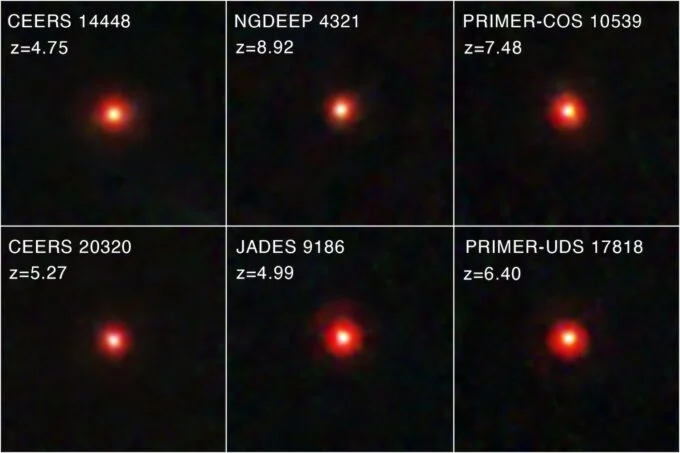The James Webb Space Telescope (JWST) has quickly emerged as a powerhouse of cosmic discovery. While its mission promised to deepen our understanding of the universe, few could have predicted the nearly paradigm-shifting observations that came to light not long after its launch in late 2021. Among its more surprising findings was the enigma of the “little red dots” (LRDs). These faint, unassuming objects, nestled in the farthest corners of the cosmos, perplexed astronomers and even raised a startling question: Could our current understanding of cosmology be incomplete—or worse, fundamentally flawed? What initially appeared to be a threat to established science ultimately became an opportunity to rewrite a crucial chapter of cosmic history.

credit: NASA
About a year into JWST’s operational phase, astronomers began noticing these puzzling LRDs in regions where light had traveled for more than 13 billion years. These objects existed within the universe’s infancy, corresponding to a time between 600 million and 1.5 billion years after the Big Bang. Their faint, red appearance in the telescope’s observations indicated extreme distance and, by extension, great age. However, these objects defied explanation. Unlike other celestial phenomena, they seemingly vanished from existence as the universe aged, leaving no comparable counterparts in later cosmic epochs. Their individuality and timing didn’t align with existing models of galaxy formation and evolution. For researchers, this posed a provocative question: Could this anomaly indicate a fundamental gap in our understanding of the universe?
As alarm bells rang across the scientific community, a group of researchers, led by Dale Kocevski of Colby College, stepped forward to solve the cosmic mystery. Through rigorous analysis, the team found a groundbreaking explanation that turned the problem on its head. These “little red dots,” far from being random anomalies, turned out to be powerhouses of energy, housing supermassive black holes at their centers. These black holes were actively consuming surrounding matter, creating what astronomers call active galactic nuclei (AGN). These hyper-luminous regions are hubs of energy release, with orbiting gas particles moving at speeds approaching 2 million miles per hour (3.2 million km/h). Rather than breaking cosmological models, this discovery provided a new lens for understanding how galaxies and black holes coalesced during the universe’s formative years.
“This is how you solve the universe-breaking problem,” noted Anthony Taylor from the University of Texas at Austin, one of the researchers who worked on the project. The result reinforced how scientific progress thrives on collaboration and adaptability. What had initially seemed to threaten cosmology’s foundation ultimately bolstered it, offering new insights into the genesis of galaxies and the evolution of supermassive black holes.
Even more exciting is what this discovery represents for our understanding of the so-called “hidden growth” era of cosmic evolution. Steven Finkelstein, another prominent researcher from the University of Texas, highlighted the importance of tracking LRDs to learn more about how black holes—and the galaxies they anchor—matured over millions of years. The presence of LRDs in the early universe not only reveals a previously unseen chapter of cosmic history but also provides clues about the environments and conditions that fostered rapid black hole formation.
Despite the excitement generated by this discovery, the work is far from finished. As Dale Kocevski has pointed out, the scientific results are just the beginning. The complexity of LRDs means there may be multiple interpretations waiting to emerge as future observations refine our models. This is yet another testament to the importance of instruments like the James Webb Space Telescope, which is poised to continue its groundbreaking mission of dissecting the cosmos’ deepest mysteries.
The “little red dots” may sound innocuous in their name, but their discovery bears extraordinary implications for our understanding of the universe. These objects have provided astronomers with a window into the universe’s earliest moments, unlocking secrets about black holes and galaxy formation that once seemed untouchable. As the JWST continues to explore new depths, one thing is increasingly clear: the cosmos is far stranger, and far more fascinating, than humanity ever imagined.